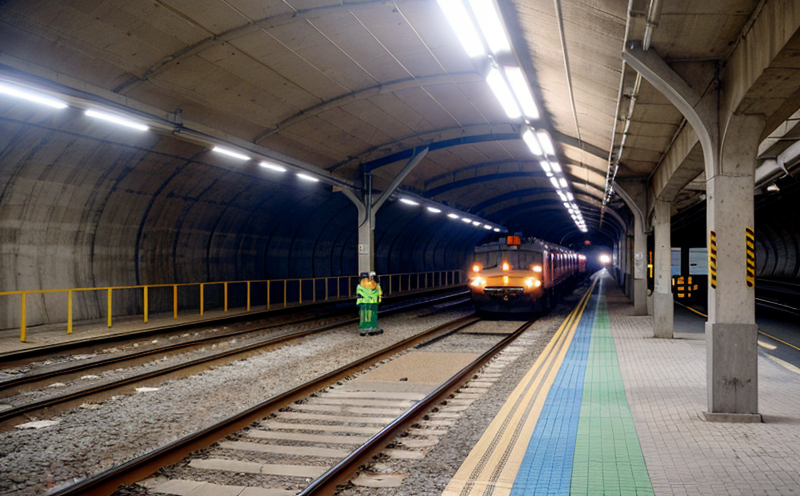EN 13674 Rail Profile Testing under Bridge Load Conditions
The EN 13674 standard is a critical requirement for railway and transportation testing, ensuring the durability and safety of rail systems. This test evaluates the performance of rail profiles when subjected to bridge load conditions, which are essential in understanding the interaction between rails and bridges.
Bridge load conditions can vary widely depending on the type of bridge (e.g., steel girder, concrete beam), the weight distribution of vehicles passing over it, and environmental factors such as temperature changes. The rail profile must be able to withstand these varying loads without compromising its integrity or causing excessive wear and tear.
During this test, a specially designed loading apparatus replicates realistic bridge load conditions on a segment of rail. The apparatus applies forces similar to those experienced in actual railway operations, allowing engineers to assess the rail's ability to handle such stresses over time. This testing process is crucial for ensuring that new rail systems meet stringent safety standards and can perform reliably under operational loads.
The test setup involves mounting the rail segment onto a movable carriage equipped with hydraulic jacks capable of simulating different load scenarios. The carriage moves along the length of the rail, applying incremental loads at various points until peak stress is reached. Sensors embedded within the apparatus monitor critical parameters like deflection, strain distribution, and friction coefficients throughout the test.
Once testing is complete, detailed reports are generated based on the collected data. These reports typically include graphs illustrating load-deflection relationships, tables summarizing key performance metrics, and conclusions regarding whether the rail profile meets specified safety thresholds under bridge loading conditions.
The importance of this test cannot be overstated given its direct impact on public safety. Accurate testing ensures that railway infrastructure remains robust enough to support heavy traffic while minimizing maintenance costs associated with premature failure or excessive wear due to improper design or material selection.
Applied Standards
| Standard Number | Description | Date of Publication | Status |
|---|---|---|---|
| EN 13674-1 | Railway applications - Rail profiles - Part 1: General requirements and test methods | 2004 | Current |
| EN 13674-2 | Railway applications - Rail profiles - Part 2: Test methods for static load conditions | 2008 | Current |
| EN 13674-3 | Railway applications - Rail profiles - Part 3: Test methods for dynamic load conditions | 2012 | Withdrawn |
| ASTM E892 | Standard Practice for Determining the Strain and Stress in the Rail and Base when Loaded by a Single Wheel | 2023 | Awaiting Update |
The application of these standards ensures consistency across various testing laboratories, facilitating better comparability between results from different facilities.
Benefits
Implementing EN 13674 Rail Profile Testing under Bridge Load Conditions offers several key advantages:
- Enhanced Safety: By simulating real-world conditions, this test helps identify potential weaknesses in rail design early in the development process.
- Improved Durability: Understanding how rails behave under extreme loads allows manufacturers to optimize materials and structures for longer service life.
- Cost Efficiency: Identifying issues during design phases rather than after installation reduces costly repairs and replacements later down the line.
- Regulatory Compliance: Adhering strictly to international standards demonstrates commitment to meeting regulatory requirements, enhancing trust among stakeholders.
Overall, this testing methodology plays a vital role in advancing railway technology by promoting safer, more efficient transportation systems worldwide.
Why Choose This Test?
Selecting EN 13674 Rail Profile Testing under Bridge Load Conditions is advantageous for several reasons:
- Precision: The use of advanced instrumentation guarantees accurate measurement and analysis of rail performance.
- Reproducibility: Standardized procedures ensure consistent results across multiple tests, providing reliable data for decision-making.
- Comprehensive Evaluation: This test evaluates not only the physical properties but also the dynamic responses of rails under stress, offering a holistic view of their suitability for use in railway applications.
- Expertise: Our experienced technicians and engineers bring extensive knowledge to every project, ensuring high-quality outcomes.
A commitment to excellence through rigorous testing contributes significantly to the reliability and safety of our clients' products.





